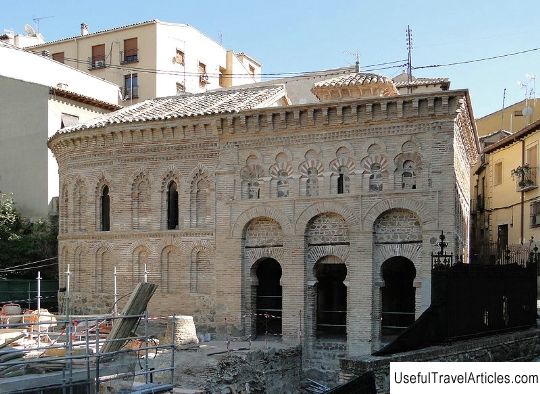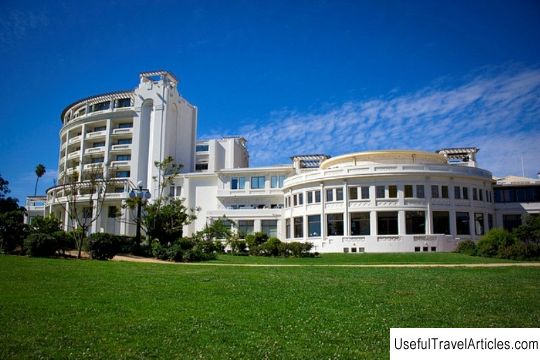Former Cristo de la Luz Mosque description and photos - Spain: Toledo

Former Cristo de la Luz Mosque description and photos - Spain: Toledo. Detailed information about the attraction. Description, photographs and a map showing the nearest significant objects. The title in English is Cristo de la Luz. Photo and descriptionIn the suburb of Toledo, San Nicolas, is the building of the former Mosque of Cristo de la Luz. It is one of the best-preserved mosques in Spain and one of the oldest structures in Toledo. The mosque, named Bab al-Mardum, was built in 999 under the leadership of the Arab architect Moussa ibn Ali de Saad, whose work was greatly influenced by the great mosque of Cordoba. There is evidence that the mosque was built on the remains of a former Visigothic temple located here. After the expulsion of the Arabs from Toledo, by order of King Alfonso VI, the mosque was transformed into a Christian temple dedicated to the Savior and named Cristo de la Luz. The facade of the building on the southwest side is decorated with an inscription indicating the time of its construction, and praising the greatness of Allah. The northern facade attracts attention with its original brickwork and multi-colored tiles. The entrances to the building are shaped like horseshoe arches. The upper part of the facade is decorated with an original frieze, the roof of the building is supported by graceful brackets. Thanks to the many rather large windows, the interior of the church is well lit with light. In one of the parts inside the church, the vault consists of nine domes, which are supported by rows of columns decorated with Visigothic capitals. Particularly noteworthy are the frescoes located inside the church and dating back to the 13th century. In the process of converting the mosque into a Catholic church, an apse was added to it, in the construction of which they used the same stone and the same decoration as in the main building. The northern facade attracts attention with its original brickwork and multi-colored tiles. The entrances to the building are shaped like horseshoe arches. The upper part of the facade is decorated with an original frieze, the roof of the building is supported by graceful brackets. Thanks to the many rather large windows, the interior of the church is well lit with light. In one of the parts inside the church, the vault consists of nine domes, which are supported by rows of columns decorated with Visigothic capitals. Particularly noteworthy are the frescoes located inside the church and dating back to the 13th century. In the process of converting the mosque into a Catholic church, an apse was added to it, in the construction of which they used the same stone and the same decoration as in the main building. The northern facade attracts attention with its original brickwork and multi-colored tiles. The entrances to the building are shaped like horseshoe arches. The upper part of the facade is decorated with an original frieze, the roof of the building is supported by graceful brackets. Thanks to the many rather large windows, the interior of the church is well lit with light. In one of the parts inside the church, the vault consists of nine domes, which are supported by rows of columns decorated with Visigothic capitals. Particularly noteworthy are the frescoes located inside the church and dating back to the 13th century. In the process of converting the mosque into a Catholic church, an apse was added to it, in the construction of which they used the same stone and the same decoration as in the main building. The entrances to the building are shaped like horseshoe arches. The upper part of the facade is decorated with an original frieze; the roof of the building is supported by graceful brackets. Thanks to the many rather large windows, the interior of the church is well lit with light. In one of the parts inside the church, the vault consists of nine domes, which are supported by rows of columns decorated with Visigothic capitals. Particularly noteworthy are the frescoes located inside the church and dating back to the 13th century. In the process of converting the mosque into a Catholic church, an apse was added to it, in the construction of which they used the same stone and the same decoration as in the main building. The entrances to the building are shaped like horseshoe arches. The upper part of the facade is decorated with an original frieze; the roof of the building is supported by graceful brackets. Thanks to the many rather large windows, the interior of the church is well lit with light. In one of the parts inside the church, the vault consists of nine domes, which are supported by rows of columns decorated with Visigothic capitals. Particularly noteworthy are the frescoes located inside the church and dating back to the 13th century. In the process of converting the mosque into a Catholic church, an apse was added to it, in the construction of which they used the same stone and the same decoration as in the main building. Thanks to the many rather large windows, the interior of the church is well lit with light. In one of the parts inside the church, the vault consists of nine domes, which are supported by rows of columns decorated with Visigothic capitals. Particularly noteworthy are the frescoes located inside the church and dating back to the 13th century. In the process of converting the mosque into a Catholic church, an apse was added to it, in the construction of which they used the same stone and the same decoration as in the main building. Thanks to the many rather large windows, the interior of the church is well lit with light. In one of the parts inside the church, the vault consists of nine domes, which are supported by rows of columns decorated with Visigothic capitals. Particularly noteworthy are the frescoes located inside the church and dating back to the 13th century. In the process of converting the mosque into a Catholic church, an apse was added to it, in the construction of which they used the same stone and the same decoration as in the main building.      We also recommend reading Wat Ngam Muang description and photos - Thailand: Chiang Rai Topic: Former Cristo de la Luz Mosque description and photos - Spain: Toledo. |




